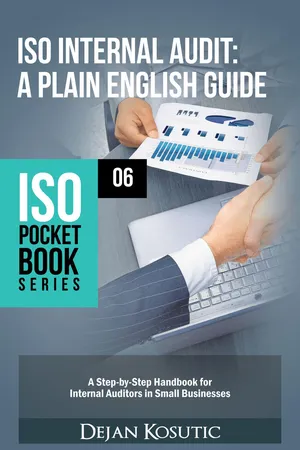
ISO Internal Audit – A Plain English Guide
A Step-by-Step Handbook for Internal Auditors in Small Businesses
- English
- ePUB (mobile friendly)
- Available on iOS & Android
ISO Internal Audit – A Plain English Guide
A Step-by-Step Handbook for Internal Auditors in Small Businesses
About this book
Let's be realistic – it is human to make mistakes, so it's impossible to have a system with no errors; it is, however, possible to have a system that improves itself and learns from its mistakes. Internal audits are a crucial part of such a system. In this book, Dejan Kosutic, an author, and experienced ISO consultant is giving away his practical know-how on ISO 9001, ISO 14001, ISO 27001, ISO 22301, ISO 20000, ISO 22000, OHSAS 18001, ISO 13485, AS9100 and IATF 16949 internal audits.
This book is written primarily for beginners in internal auditing and for people with moderate knowledge about internal audits. On the other hand, if you do have experience with internal audits, but you feel that you still have gaps in your knowledge, you'll also find this book helpful. So, no matter if you are new or experienced in the field, this book gives you everything you will ever need to learn and more about internal audits.
Inside you will find not just basic information about the internal audit and ISO 19011 but also information on how to create the internal audit checklist, how to write the internal audit report, what are the best technics for finding evidence during the audit, how to perform interviewing during the audit and much more.
Kosutic uses real-life examples and plain English in order to explain everything that is necessary to completely understand how to perform an internal audit for all ISO management standards.
Frequently asked questions
- Essential is ideal for learners and professionals who enjoy exploring a wide range of subjects. Access the Essential Library with 800,000+ trusted titles and best-sellers across business, personal growth, and the humanities. Includes unlimited reading time and Standard Read Aloud voice.
- Complete: Perfect for advanced learners and researchers needing full, unrestricted access. Unlock 1.4M+ books across hundreds of subjects, including academic and specialized titles. The Complete Plan also includes advanced features like Premium Read Aloud and Research Assistant.
Please note we cannot support devices running on iOS 13 and Android 7 or earlier. Learn more about using the app.
Information
1
INTRODUCTION
1.1 Why companies need internal audits
1.2 ISO 19011 – A standard focused on auditing
1.3 Who should read this book?
1.4 How to read this book
- Some sections contain tips for free tools and for documents that are to be used during the internal audit.
- At the ends of the most important chapters, you’ll see a section called “Success factors,” which will emphasize what you need to focus on.
- At the end of this book you’ll see a chapter that will help you decide whether you want to pursue your career in becoming a certification auditor.
1.5 What this book is not
1.6 Additional resources
- ISO online courses – free online trainings for ISO 9001, ISO 14001, and ISO 27001 internal auditors.
- ISO 27001 free downloads, ISO 9001 free downloads, and ISO 14001 free downloads – a collection of white papers, checklists, diagrams, templates, etc.
- Conformio – a cloud-based document management system (DMS) and project management tool focused on ISO standards that can be used for auditing purposes.
- ISO 9001 Internal Audit Toolkit – a set of all the documentation templates that are required for performing the internal audit; similar toolkits exist for other ISO standards.
- Official ISO webpage – here you can purchase an official version of any ISO standard.
2
BASIC THINGS ABOUT THE INTERNAL AUDIT
2.1 Internal vs. external audit
Table of contents
- COVER
- ABOUT THE AUTHOR
- TABLE OF CONTENTS
- PREFACE
- ACKNOWLEDGMENTS
- 1 INTRODUCTION
- 2 BASIC THINGS ABOUT THE INTERNAL AUDIT
- 3 ORGANIZING AN INTERNAL AUDIT
- 4 STEPS IN THE INTERNAL AUDIT PROCESS
- 5 PERFORMING THE MAIN PART OF THE AUDIT
- 6 BONUS CHAPTER: DEVELOPING AN AUDITING CAREER